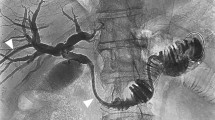Abstract
This case describes a technique used to close a long-term 14F transpleural biliary drainage catheter tract to prevent biliopleural fistula and further complications. We deployed a compressed gelatin foam pledget provided in a pre-loaded delivery device (Hep-Plug™) along the intrahepatic tissue tract for sealing it against the pleural cavity. The device used is easy to handle and gives the Interventional Radiologist the possibility to safely manage and prevent complications after percutaneous transhepatic interventions.

Similar content being viewed by others
References
Saad WE, et al. Quality improvement guidelines for percutaneous transhepatic cholangiography, biliary drainage, and percutaneous cholecystostomy. J Vasc Interv Radiol. 2010;21(6):789–95.
Herschman Z, Amin D, Lehrfield A. Bilious pleural effusion as a complication of attempted percutaneous biliary drainage. Crit Care Med. 1991;19(1):128–9.
Armstrong CP, Taylor TV. Intrapleural leakage of bile complicating percutaneous transhepatic drainage of the obstructed biliary tree. J R Coll Surg Edinb. 1982;27(5):308–9.
Strange C, et al. Biliopleural fistula as a complication of percutaneous biliary drainage: experimental evidence for pleural inflammation. Am Rev Respir Dis. 1988;137(4):959–61.
Turkington RC, et al. Cholethorax following percutaneous transhepatic biliary drainage. Ulster Med J. 2007;76(2):112–3.
Kim SH, Zangan SM. Percutaneous transhepatic biliary drainage complicated by Bilothorax. Semin Intervent Radiol. 2015;32(1):54–6.
Funaki B, et al. Percutaneous biliary drainage in patients with nondilated intrahepatic bile ducts. AJR Am J Roentgenol. 1999;173(6):1541–4.
Lorenz JM, et al. Percutaneous transhepatic cholangiography and biliary drainage in pediatric liver transplant patients. AJR Am J Roentgenol. 2001;176(3):761–5.
Sano A, Yotsumoto T. Bilothorax as a complication of percutaneous transhepatic biliary drainage. Asian Cardiovasc Thorac Ann. 2016;24(1):101–3.
Tsuyuguchi T, et al. Techniques of biliary drainage for acute cholangitis: Tokyo guidelines. J Hepatobiliary Pancreat Surg. 2007;14(1):35–45.
Nichols DM, et al. The safe intercostal approach? Pleural complications in abdominal interventional radiology. Am J Roentgenol. 1984;142(5):1013–8.
Weber A, et al. Complications of percutaneous transhepatic biliary drainage in patients with dilated and nondilated intrahepatic bile ducts. Eur J Radiol. 2009;72(3):412–7.
Garcarek J, et al. Ten years single center experience in percutaneous transhepatic decompression of biliary tree in patients with malignant obstructive jaundice. Adv Clin Exp Med. 2012;21(5):621–32.
Isenburg J, Penegor S, Beam S, Dingfelder C. Preclinical evaluation of a bioresorbable device for transhepatic tract closure. Poster Session SIR Ann Meeeting, Abstract No. 678, Submission Number 1661. 2016.
Author information
Authors and Affiliations
Corresponding author
Ethics declarations
Conflict of interest
Dr. Kortes has nothing to disclose. Dr. Gnutzmann reports grants and other from Celonova Biosciences Inc., grants and other from BTG, outside the submitted work. Mr. Konietzke has nothing to disclose. Dr. Mayer has nothing to disclose. Dr. Sumkauskaite has nothing to disclose. Prof. Dr. Kauczor reports grants, personal fees and non-financial support from Siemens, personal fees from Boehringer Ingelheim, personal fees and non-financial support from Bayer, personal fees from GSK, personal fees from Novartis, personal fees from Astra Zeneca, personal fees from Philips, personal fees from Bracco, outside the submitted work. Prof. Dr. Radeleff has nothing to disclose.
Rights and permissions
About this article
Cite this article
Kortes, N., Gnutzmann, D., Konietzke, P. et al. Occlusion of a Long-Term Transpleural Biliary Drainage Tract Using a Gelatin Pledget (Hep-Plug™). Cardiovasc Intervent Radiol 40, 1800–1803 (2017). https://doi.org/10.1007/s00270-017-1695-0
Received:
Accepted:
Published:
Issue Date:
DOI: https://doi.org/10.1007/s00270-017-1695-0




